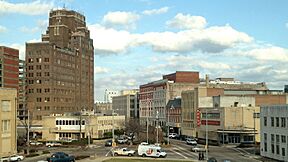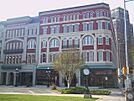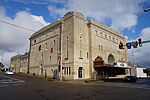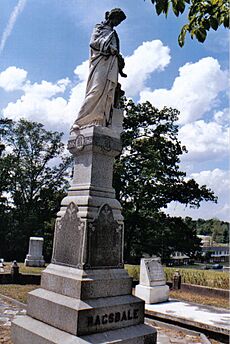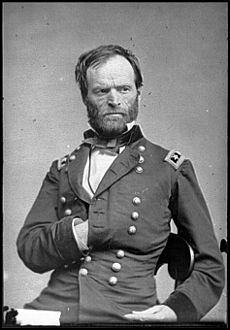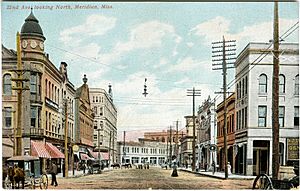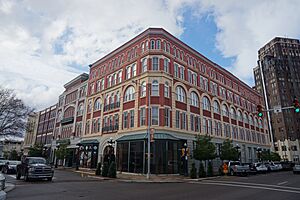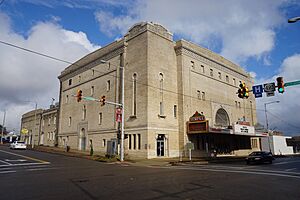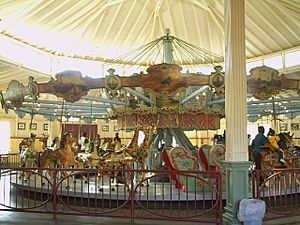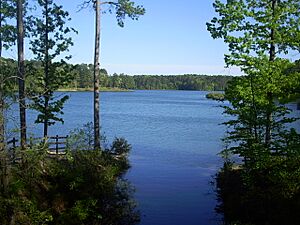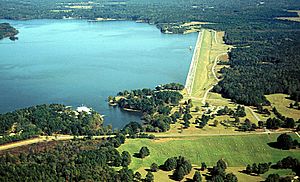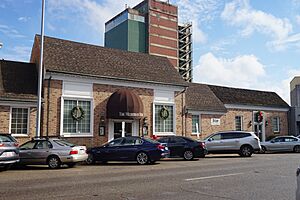Meridian, Mississippi facts for kids
Quick facts for kids
Meridian, Mississippi
|
||
|---|---|---|
|
A view of downtown from the third floor of Meridian City Hall; the 16-story Threefoot Building dominates the skyline
Riley Center
|
||
|
||
| Nickname(s):
Queen City
|
||
| Motto(s):
"A Better Longitude On Life"
|
||
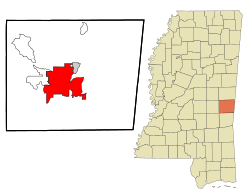
Location of Meridian in Lauderdale County
|
||
| Country | United States | |
| State | Mississippi | |
| County | Lauderdale | |
| Incorporated | February 10, 1860 | |
| Government | ||
| • Type | Mayor-council government | |
| Area | ||
| • City | 54.51 sq mi (141.17 km2) | |
| • Land | 53.74 sq mi (139.19 km2) | |
| • Water | 0.76 sq mi (1.98 km2) | |
| Elevation | 344 ft (105 m) | |
| Population
(2020)
|
||
| • City | 35,052 | |
| • Density | 652.24/sq mi (251.83/km2) | |
| • Metro | 107,449 | |
| Time zone | UTC−6 (CST) | |
| • Summer (DST) | UTC−5 (CDT) | |
| ZIP code(s) |
39301-39307
|
|
| Area code(s) | 601 | |
| FIPS code | 28-46640 | |
| GNIS feature ID | 0673491 | |
Meridian is a city in the U.S. state of Mississippi. It is the eighth largest city in Mississippi. In 2020, about 35,052 people lived there. Meridian is the main city of Lauderdale County. It is also the county seat.
Meridian was started in 1860. It grew because it was a meeting point for two major railroads. This made it an important trading center. During the American Civil War, General William Tecumseh Sherman burned much of the city. But Meridian was rebuilt quickly after the war.
The city then entered a "Golden Age." From 1890 to 1930, it was the largest city in Mississippi. It became a top manufacturing center in the South. About 44 trains arrived and left daily. Today, Union Station is a busy center for Amtrak trains and Greyhound Buses.
Even though the railroad industry slowed down, Meridian's economy has grown in other ways. Now, healthcare, military, and manufacturing are the biggest employers. Two military bases, Naval Air Station Meridian and Key Field, provide over 4,000 jobs. Key Field is named after brothers Fred and Al Key. They set a world record for how long they could fly in 1935.
Meridian has many cool places for arts and history. These include the Riley Center, the Meridian Museum of Art, and the Meridian Little Theatre. Jimmie Rodgers, known as the "Father of Country Music," was born here. You can visit a museum about him in Highland Park. The park also has the Highland Park Dentzel Carousel, which is a very special historic ride.
Contents
Exploring Meridian's Past
How Meridian Began
Long ago, the Choctaw Native Americans lived in the area where Meridian is now. The United States got this land in 1830. This happened after the Treaty of Dancing Rabbit Creek. Soon, European-American settlers started moving in.
Richard McLemore was the first settler in Meridian. He received a large piece of land. He offered free land to new people to help the area grow. In 1853, a lawyer named Lewis A. Ragsdale bought most of McLemore's land. John T. Ball, a merchant, bought the rest. Ragsdale and Ball are known as the city's founders. They started planning out areas for new buildings.
People argued about what to name the new settlement. Ball and others who liked industry wanted "Meridian." They thought it meant "junction" because of the railroads. Farmers preferred "Sowashee," which meant "mad river" in Choctaw. Ragsdale wanted "Ragsdale City." Ball put up a sign at the railroad station that changed between "Meridian" and "Sowashee" each day. But more railroad workers moved in, and they kept "Meridian" on the sign for good. The town officially became Meridian on February 10, 1860.
Civil War and Rebuilding
When the American Civil War started in 1861, Meridian was a small town. But the Confederates used its important location at the railroad crossing. They built military bases there. In 1864, Union General William Tecumseh Sherman led his troops into the city. He destroyed the railroads, weapons, and supply buildings. He burned many buildings to the ground. Sherman reportedly said, "Meridian... no longer exists."
Even with all the damage, workers fixed the railroad lines very quickly. They were working again just 26 days after the battle. After the war, during the Reconstruction era, there were tensions. White people did not want formerly enslaved African Americans to have new freedoms. In 1871, a fire damaged many businesses. Then, a riot broke out. White people attacked Black people in the community.
Meridian's "Golden Age"
After the Civil War, the town grew very fast. It had its "Golden Age" from 1880 to 1910. The railroads helped people travel and moved goods for factories. This made businesses and the population grow a lot. Downtown Meridian became very busy. Between 1890 and 1930, Meridian was the biggest city in Mississippi. It was a major center for manufacturing in the South.
Because the economy was strong, people built many beautiful buildings. These are now historic places. They include the Grand Opera House (1890) and the Wechsler School (1894). Two Carnegie libraries were built in 1913. The Threefoot Building, Meridian's tallest skyscraper, was built in 1929.

The city kept growing. In 1913, a special city government helped bring in 90 new factories. The car industry also boomed in the 1920s. Even during the Great Depression, the city still attracted new businesses. People wanted to escape their worries during the Depression. So, the S. H. Kress & Co. building opened downtown. It was meant to "provide luxury to the common man." The Temple Theater also opened as a movie house. The federal courthouse was built in 1933 as a project to create jobs.
The economy slowed down a bit at the end of the Depression. But World War II made railroads important again. They were needed to move fuel and metal for military vehicles. Meridian became a rail center once more. This good time lasted until the 1950s. Then, cars became affordable, and new highways were built. People stopped using trains as much. This caused many job losses, and the city's population went down.
Civil Rights Era
During the American Civil Rights Movement in the 1960s, Meridian was a center for activism. James Chaney and other local people worked with volunteers from New York City. They wanted to create a community center. During Freedom Summer, they held classes to help African Americans register to vote. White people in the area did not like this activism. They attacked civil rights workers.
In June 1964, Chaney and two volunteers, Michael Schwerner and Andrew Goodman, went to Neshoba County, Mississippi. They were going to meet with members of a Black church that had been bombed. The three disappeared that night on their way back to Meridian.
Later, seven members of a hate group, including a deputy sheriff, were found guilty. They were convicted in the federal courthouse in Meridian. This was the first time an all-white jury found a white official guilty in a civil rights killing. In 2005, the state charged Edgar Ray Killen in the case. He was found guilty of manslaughter and sent to prison. Meridian later honored James Chaney by renaming a street after him.
Modern Times in Meridian
Starting in the 1960s, people began moving away from downtown. They moved to new neighborhoods in the north because highways made it easy to commute. The city worked to protect its historic buildings in the 1970s and 80s. Groups like Meridian Main Street helped bring downtown back to life.
They built a new Amtrak Station in 1997. It looked like the old train station from Meridian's "Golden Age." Other projects included fixing up old buildings like the Rosenbaum Building and Weidmann's Restaurant. The historic Grand Opera House was also renovated in 2006. It is now the "Mississippi State University Riley Center for Education and the Performing Arts." This center brings many visitors to downtown Meridian.
Today, groups like the Alliance for Downtown Meridian work to help downtown grow. They want to attract shops, restaurants, and bars to make downtown lively day and night.
Historic Hotels
 |
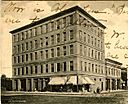 |
| Great Southern Hotel (1890) | Hotel Meridian (1907) |
 |
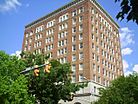 |
| Union Hotel (1908) | Lamar Hotel (1927) |
Because Meridian was a railroad hub, many hotels were built for travelers. Even before its "Golden Age," hotels like the Great Southern and Grand Avenue hotels were built. When the original Union Station was built in 1906, more hotels like the Elmira Hotel and Terminal Hotel opened. The Hotel Meridian (1907) and Union Hotel (1908) were also built.
As the city grew, hotels became grander. The 11-story skyscraper Lamar Hotel was built in 1927. The E.F. Young Hotel (1931) was important for African American travelers during segregation. It was one of the few places where Black travelers could find a room.
When suburbs grew in the 1960s and 70s, most hotels moved out of downtown. But the renovation of the Riley Center has brought new interest in downtown hotels.
Historic Areas to Explore
Meridian has nine special historic areas listed on the National Register of Historic Places. These areas show many different building styles from the late 1800s and early 1900s. You can see styles like Queen Anne, Colonial Revival, and Art Deco. These districts help protect the city's unique look.
The districts are:
- 1 East End Historic District
- 2 Highlands Historic District
- 3 Meridian Downtown Historic District
- 4 Meridian Urban Center Historic District
- 5 Union Station Historic District
- 6 Merrehope Historic District
- 7 Mid-Town Historic District
- 8 Poplar Springs Road Historic District
- 9 West End Historic District
Meridian's Location and Weather
Where is Meridian?
Meridian is in the East Central Hills region of Mississippi. It is located in Lauderdale County. The city covers about 54.5 square miles. Most of this is land, with a small amount of water.
Meridian is about 93 miles east of Jackson, Mississippi. It's also 154 miles west of Birmingham, Alabama. The area around the city has many oak and pine trees. The land has rolling clay hills and lowlands near the Chickasawhay River.
Small creeks run through the city. Sowashee Creek flows through the southern part. There are also small lakes and woodlands in the northern and southern areas.
Meridian's Climate
Meridian has a humid subtropical climate. This means it has hot, humid summers and mild winters. In summer (June to August), the average high temperature is around 90°F (32°C). The average low is around 70°F (21°C). In winter (December to February), the average high is about 60°F (16°C), and the low is around 35°F (2°C). July is usually the warmest month. January is the coldest.
The city gets about 57 inches (145 cm) of rain each year. Rain falls pretty evenly throughout the year. March is the wettest month. Thunderstorms are common in summer and can happen all year. Sometimes, severe thunderstorms bring strong winds or large hail. These are most common in spring and fall. Tornadoes can also happen.
| Climate data for Meridian (Meridian Regional Airport), Mississippi (1991–2020 normals, extremes 1889–present) | |||||||||||||
|---|---|---|---|---|---|---|---|---|---|---|---|---|---|
| Month | Jan | Feb | Mar | Apr | May | Jun | Jul | Aug | Sep | Oct | Nov | Dec | Year |
| Record high °F (°C) | 83 (28) |
86 (30) |
93 (34) |
95 (35) |
99 (37) |
104 (40) |
107 (42) |
106 (41) |
105 (41) |
102 (39) |
89 (32) |
84 (29) |
107 (42) |
| Mean maximum °F (°C) | 74.7 (23.7) |
78.3 (25.7) |
83.9 (28.8) |
87.0 (30.6) |
92.5 (33.6) |
95.7 (35.4) |
98.3 (36.8) |
98.1 (36.7) |
95.3 (35.2) |
89.8 (32.1) |
81.3 (27.4) |
76.2 (24.6) |
99.5 (37.5) |
| Mean daily maximum °F (°C) | 59.0 (15.0) |
63.8 (17.7) |
71.2 (21.8) |
78.2 (25.7) |
85.3 (29.6) |
91.0 (32.8) |
93.3 (34.1) |
93.1 (33.9) |
88.9 (31.6) |
79.5 (26.4) |
68.7 (20.4) |
61.1 (16.2) |
77.8 (25.4) |
| Daily mean °F (°C) | 47.7 (8.7) |
51.7 (10.9) |
58.5 (14.7) |
65.4 (18.6) |
73.3 (22.9) |
80.0 (26.7) |
82.7 (28.2) |
82.2 (27.9) |
77.3 (25.2) |
66.6 (19.2) |
55.8 (13.2) |
49.9 (9.9) |
65.9 (18.8) |
| Mean daily minimum °F (°C) | 36.4 (2.4) |
39.7 (4.3) |
45.9 (7.7) |
52.6 (11.4) |
61.3 (16.3) |
68.9 (20.5) |
72.0 (22.2) |
71.3 (21.8) |
65.6 (18.7) |
53.7 (12.1) |
42.9 (6.1) |
38.6 (3.7) |
54.1 (12.3) |
| Mean minimum °F (°C) | 18.2 (−7.7) |
22.6 (−5.2) |
27.4 (−2.6) |
35.1 (1.7) |
45.3 (7.4) |
57.9 (14.4) |
64.1 (17.8) |
62.4 (16.9) |
50.5 (10.3) |
35.3 (1.8) |
26.3 (−3.2) |
22.6 (−5.2) |
16.0 (−8.9) |
| Record low °F (°C) | 0 (−18) |
−6 (−21) |
15 (−9) |
28 (−2) |
38 (3) |
42 (6) |
54 (12) |
49 (9) |
34 (1) |
24 (−4) |
16 (−9) |
2 (−17) |
−6 (−21) |
| Average precipitation inches (mm) | 5.61 (142) |
5.35 (136) |
5.66 (144) |
5.56 (141) |
4.20 (107) |
4.64 (118) |
5.11 (130) |
4.36 (111) |
3.17 (81) |
3.86 (98) |
4.21 (107) |
5.27 (134) |
57.00 (1,448) |
| Average snowfall inches (cm) | 0.2 (0.51) |
0.0 (0.0) |
0.3 (0.76) |
0.0 (0.0) |
0.0 (0.0) |
0.0 (0.0) |
0.0 (0.0) |
0.0 (0.0) |
0.0 (0.0) |
0.0 (0.0) |
0.0 (0.0) |
0.1 (0.25) |
0.6 (1.5) |
| Average precipitation days (≥ 0.01 in) | 9.9 | 10.4 | 10.0 | 8.7 | 9.1 | 10.7 | 11.9 | 9.9 | 7.0 | 6.8 | 8.3 | 10.4 | 113.1 |
| Average snowy days (≥ 0.1 in) | 0.2 | 0.1 | 0.1 | 0.0 | 0.0 | 0.0 | 0.0 | 0.0 | 0.0 | 0.0 | 0.0 | 0.1 | 0.5 |
| Average relative humidity (%) | 74.4 | 71.1 | 69.4 | 70.4 | 73.1 | 73.9 | 76.7 | 76.7 | 76.3 | 74.7 | 74.8 | 74.8 | 73.9 |
| Source 1: NOAA | |||||||||||||
| Source 2: World Meteorological Organization (relative humidity 1961–1990) | |||||||||||||
People and Community
Population Changes Over Time
| Historical population | |||
|---|---|---|---|
| Census | Pop. | %± | |
| 1870 | 2,709 | — | |
| 1880 | 4,008 | 48.0% | |
| 1890 | 10,624 | 165.1% | |
| 1900 | 14,050 | 32.2% | |
| 1910 | 23,285 | 65.7% | |
| 1920 | 23,339 | 0.2% | |
| 1930 | 31,954 | 36.9% | |
| 1940 | 35,481 | 11.0% | |
| 1950 | 41,893 | 18.1% | |
| 1960 | 49,374 | 17.9% | |
| 1970 | 45,083 | −8.7% | |
| 1980 | 46,577 | 3.3% | |
| 1990 | 41,036 | −11.9% | |
| 2000 | 39,968 | −2.6% | |
| 2010 | 41,148 | 3.0% | |
| 2020 | 35,052 | −14.8% | |
| Source: US Census data | |||
| Race | Num. | Perc. |
|---|---|---|
| White | 9,949 | 28.38% |
| Black or African American | 22,967 | 65.52% |
| Native American | 49 | 0.14% |
| Asian | 354 | 1.01% |
| Pacific Islander | 17 | 0.05% |
| Other/Mixed | 922 | 2.63% |
| Hispanic or Latino | 794 | 2.27% |
In 2020, there were 35,052 people living in Meridian. There were 15,947 households and 9,285 families.
The city's population has changed a lot over time. It grew steadily from when it started until 1970. Then, it went down a bit. After 2000, the population started to increase again.
Meridian is the main city in the Meridian micropolitan area. This area includes three counties and had about 106,139 people in 2009. Meridian is a central place for jobs, shopping, healthcare, and cultural activities for many people.
The number of non-white residents has grown over time. In 2010, about 61.55% of the people were African American. About 35.71% were White. Other groups included Asian, Native American, and people of two or more races.
In 2000, the average household had 2.39 people. The average family had 3.06 people. The average age in Meridian has gone up. It was 30.4 in 1970 and 34.6 in 2000.
The median income for a household in 2000 was $25,085. For a family, it was $31,062. About 28.6% of the population lived below the poverty line. This included many young people and older adults.
Religious Life
Many people in Meridian and Lauderdale County are part of a religious group. About 65.2% of people in Lauderdale County are connected to a religious congregation. This is higher than the national average. In 2000, most people were Southern Baptist. Others were with the United Methodist Church or the Catholic Church.
Jewish immigrants from Germany and Eastern Europe helped build businesses in the city. Congregation Beth Israel was founded in 1868. Meridian once had the largest Jewish community in Mississippi. Today, fewer Jewish people live in the city.
Meridian's Economy
| Employer | Industry type | Employees |
|---|---|---|
| NAS Meridian | Military | 3,000 |
| Rush Health Systems | Healthcare | 2,465 |
| Anderson Regional Health System | Healthcare | 1,343 |
| Mississippi Air National Guard | Military | 1,200 |
| Meridian Public School District | Education | 1,000 |
| East Mississippi State Hospital | Healthcare | 943 |
| Lauderdale County School District | Education | 938 |
| Walmart | Retail | 695 |
| City of Meridian | Government | 530 |
| iQor | Customer Service | 420 |
| Alliance Health Center | Healthcare | 350 |
| Meridian Community College | Education | 325 |
| Avery Dennison | Manufacturing | 250 |
| Peavey Electronics | Manufacturing | 250 |
| Van Zyverden, Inc. | Flower Bulb Distribution | 250 |
| Structural Steel Services | Manufacturing | 236 |
| Atlas Roofing | Manufacturing | 220 |
| Newell Paper | Wholesale | 215 |
| Lockheed Martin | Manufacturing | 200 |
| Tower Automotive | Automotive | 200 |
| Bimbo Bakeries USA | Food | 185 |
| Mitchell Distributing | Distribution | 120 |
| Magnolia Steel | Manufacturing | 107 |
| Southern Pipe and Supply | Distribution | 102 |
| Southern Cast Products | Manufacturing | 81 |
Meridian's early economy relied heavily on railroads. Around 1900, it was the largest city in Mississippi. It had five major rail lines and 44 trains coming and going daily. The city's economy depended on the rails and the goods they carried, like timber and cotton. This made Meridian a strong economic power from about 1890 to 1930.
When the railroad industry declined in the 1950s, the city changed. It moved from a railroad-based economy to a more varied one. Now, healthcare, military, and manufacturing provide the most jobs.
Meridian is a hub for jobs, shopping, healthcare, and culture. Many people from nearby areas come to Meridian for work.
Key Industries
- Healthcare: In April 2020, over 5,100 people worked in healthcare in Lauderdale County. Rush Health Systems is the biggest healthcare employer. There are two hospitals in Meridian and many other health facilities.
- Retail: Retail is another big employer, with over 5,280 people working in April 2010. People spend nearly $2 billion on shopping in the city each year. Uptown Meridian has over a hundred shops and restaurants. New shopping centers have also boosted retail in the area.
- Military: Two military bases, Naval Air Station Meridian and Key Field, provide over 4,000 jobs. NAS Meridian trains naval pilots. Key Field is home to the 186th Air Refueling Wing of the Air National Guard. It also has a museum about aviation history.
- Manufacturing: In April 2010, about 2,850 people worked in manufacturing. Peavey Electronics Corporation, which makes guitars and sound equipment, has its main office here. Other companies include Avery Dennison and Bimbo Bakeries USA. The city also has four industrial parks.
The MSU Riley Center downtown brings in money from tourism, arts, and entertainment. It attracts over 60,000 visitors each year for events. Loeb's Department Store has been selling clothes since 1887 and is still a landmark.
Arts and Fun in Meridian
Arts and Culture
The Meridian Art League started in 1933. It later became the Meridian Art Association. In 1970, the group opened the Meridian Museum of Art in an old Carnegie library building. The museum shows many different types of art. It also has educational programs for kids and adults.
The Meridian Council for the Arts (MCA) helps support arts groups in the city. It puts on the annual Threefoot Festival. MCA works with the Meridian Museum of Art, the Meridian Little Theatre, and the Meridian Symphony Orchestra. The Meridian Little Theatre is one of the oldest community theaters in the South. The Meridian Symphony Orchestra has been playing concerts since 1962.
Meridian's old Grand Opera House was built in 1889. It hosted many famous artists. It closed in the late 1920s. But in 2006, it was beautifully restored and renamed the "Mississippi State University Riley Center for Education and Performing Arts." The Riley Center has a 950-seat theater for live shows. It also has meeting spaces. It brings over 60,000 visitors to downtown Meridian every year.
Meridian is known for its amazing old buildings. Many were designed by famous architects. The Threefoot Building is considered one of the best Art Deco skyscrapers in the U.S.
The Mississippi Arts and Entertainment Experience (the MAX) is located downtown. It has a "Walk of Fame" outside the Riley Center. The first star was for Jimmie Rodgers. Other stars honor famous Mississippians like B.B. King, Tennessee Williams, and Sela Ward.
The Hamasa Shrine Temple Theater is another place for big shows. It has a huge pipe organ. It used to be one of the largest stages in the U.S. Today, it hosts live shows, plays, concerts, and classic movie screenings.
Highland Park has a Jimmie Rodgers museum. It shows his guitar and other items. There's also old railroad equipment. A special marker in Meridian honors Jimmie Rodgers as the "Father of Country Music." The city holds a festival every May to remember him.
The park is also home to a 19th-century carousel. The Highland Park Dentzel Carousel was built around 1895. It has been running since 1909. It is a National Historic Landmark. It is the only two-row stationary Dentzel menagerie carousel in the world. There are also 62 colorful carousel horse statues around the city. Local artists painted them.
Fun and Recreation
Meridian has several parks for fun. Highland Park has picnic areas, swimming pools, tennis courts, and sports fields. Bonita Lakes is a city park with three lakes. It has nature trails, walking paths, biking trails, and places for fishing and boating. Okatibbee Lake is another large area with a lake for boating, fishing, swimming, and camping.
Since 1992, Meridian has hosted the State Games of Mississippi. This is a yearly sports event like the Olympic Games. Athletes compete in many sports. In 2009, over 4,500 athletes took part in 27 sports. The opening ceremonies are held downtown every June.
The games take place at several sports parks. Northeast Park has tennis courts, softball fields, and soccer fields. The Sammie Davidson Sports Complex also has tennis courts and softball fields.
Meridian has several golf courses. Lakeview Municipal Golf Course is open to everyone. Briarwood County Club is a private club with golf, swimming, and dining.
Getting Around Meridian
Trains and Buses

Amtrak's Crescent train connects Meridian to cities like New York, Atlanta, and New Orleans. The Union Station Multi-Modal Transportation Center is a historic building. It was built in 1906, torn down, and rebuilt in 1997. It is a hub for Amtrak trains, Norfolk Southern rail, Greyhound buses, and other transit services.
Air Travel
Meridian is served by Meridian Regional Airport, located at Key Field. It is about 3 miles southwest of the city. The airport's runway is over 10,000 feet long. This makes it the longest public runway in Mississippi. The airport has been open since 1930. It offers daily flights to Dallas/Fort Worth.
In 1935, brothers Fred and Al Key kept the airport from closing. They flew over the city for 27 days, setting a world endurance flight record. Key Field is named after them. Their record for conventional flight is still unbroken.
Major Roads
Meridian is connected by several major highways:
 Interstate 20
Interstate 20
- This highway goes west through Jackson, Mississippi. It ends in Texas. East, it goes through Tuscaloosa, Alabama, and ends in South Carolina.
 Interstate 59
Interstate 59
- This highway joins with I-20 in Meridian. It goes north through Tuscaloosa, Alabama, and ends in Georgia. South, it goes through Hattiesburg, Mississippi, to Slidell, Louisiana.
 U.S. Highway 11
U.S. Highway 11
- This road runs next to Interstate 59 south to New Orleans. North, it goes all the way to the Canada-U.S. border.
 U.S. Highway 45
U.S. Highway 45
- This highway goes north through Columbus, Mississippi, to the U.S.-Canada border. South, it goes through Quitman, Mississippi, to Mobile, Alabama, and the Gulf of Mexico.
 U.S. Highway 80
U.S. Highway 80
- This road goes west through Jackson, Mississippi, to Dallas, Texas. East, it goes through Demopolis, Alabama, all the way to Tybee Island, Georgia, and the Atlantic Ocean.
 Mississippi Highway 19
Mississippi Highway 19
- This highway goes north to West, Mississippi. South, it goes to the Mississippi-Alabama border.
 Mississippi Highway 39
Mississippi Highway 39
- This highway starts in Meridian and goes north to Shuqualak, Mississippi.
 Mississippi Highway 145
Mississippi Highway 145
- This used to be US 45, but now it's an alternate route in some cities.
 Mississippi Highway 493
Mississippi Highway 493
- This highway starts in Meridian and goes north to Lynville, Mississippi.
Learning in Meridian
Early public schools in Meridian started in the 1870s. The city built its first public school in 1884. The first public school for Black students was in a rented church building. In 1888, the city was allowed to have its own school district. The Wechsler School was built in 1894. It was the first brick public school building in Mississippi built for Black students.
Today, the Meridian Public School District has six elementary schools, three middle schools, and three high schools. There are also private schools like Lamar School. Meridian High School is the main high school. It has about 1,500 students in grades 9-12.
Meridian has two colleges. Meridian Community College started in 1937. It offers free tuition for four semesters to high school graduates from the area. Mississippi State University also has a campus in the city.
The Meridian-Lauderdale County Public Library serves the city. It is located at 7th Street and 26th Avenue. Meridian used to have two Carnegie libraries, both built in 1913. One was for white people and one for Black people. The library for Black people was the only one in the state until after World War I. In 1967, the libraries combined their collections because of new laws. The old white library became the Meridian Museum of Art. The old Black library was torn down in 2008.
News and Media
The Meridian Star is the only daily newspaper printed in the city. It has been around since 1898. It serves Lauderdale County and nearby areas.
Meridian is also a center for TV and radio. WTOK-TV is the local ABC channel. It also has channels for MyNetworkTV and CW. WMDN-TV is the CBS channel. WGBC-TV carries both FOX and NBC shows. These stations are known as "The Meridian Family of Stations." WMAW-TV is the local Mississippi Public Broadcasting channel.
For radio, WUCL (FM 105.7) is very popular. Other popular stations include WZKS (FM 104.1) and WMOX (AM 1010).
Famous People from Meridian
Many notable people were born or lived in Meridian:
- Susan Akin, who won the Miss America beauty pageant in 1986.
- John Alexander, an opera singer.
- Big K.R.I.T., a musician.
- Dennis Ray "Oil Can" Boyd, a former Major League Baseball pitcher.
- James Chaney, a civil rights activist.
- Alvin Childress, an actor known for the Amos 'n' Andy Show.
- Austin Davis, an NFL player.
- Paul Davis, a singer-songwriter.
- Fred and Al Key, famous for their world flight endurance record. Al Key was also a mayor of the city.
- Steve Forbert, a folk singer.
- Diane Ladd, an actress.
- Derrick McKey, an NBA player.
- Hartley Peavey, who founded Peavey Electronics.
- Jimmie Rodgers, the "Father of Country Music."
- David Ruffin and his brother Jimmy Ruffin, singers from The Temptations.
- Sela Ward, an actress.
- Hayley Williams, lead singer of the band Paramore.
Images for kids
-
Looking into downtown Meridian from the 22nd Avenue Bridge in 2008. The Hotel Meridian was later demolished.
See also
 In Spanish: Meridian (Misisipi) para niños
In Spanish: Meridian (Misisipi) para niños


